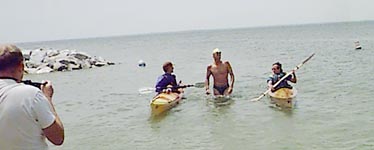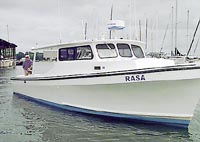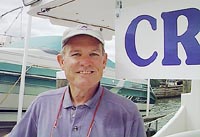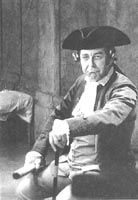7th Annual Potomac River Swim:
51-Plus Hours in a Cold ‘Washing Machine’
photos by Lori Sikorski
John and Barbara Bechtel paddle to shore with swimmer Robbie Allen, above left. Kayakers provided support, water and Powerbars for the swimmers as they crossed the mouth of the Potomac. Barbara Bechtel paddle to shore with swimmer Robbie Allen, above left. Kayakers provided support, water and Powerbars for the swimmers as they crossed the mouth of the Potomac.
Under early morning skies gray as the churning water, 13 anxious swimmers — nine men and four women — board a boat that will transport them from Point Lookout State Park in Southern Maryland, across the Potomac River to Virginia.
There will be no sightseeing. As soon as they step off the boat, their mission will begin. The seven and a half miles back will be made without the boat. In 63-degree waters, at a marked time of 8:30am they will begin swimming back to the Maryland shore.
The Seventh Annual Potomac River Swim for the Environment is underway. Joe Stewart, founder of the event and now so busy as its coordinator that he no longer swims, waits with 75 others at the park to welcome in the swimmers as, one by one, they make it across.
For the last, Bill Stergiou of New York, swim and wait will span seven hours and almost 14 minutes.
Started back in 1993, Stewart made the swim solo with only pledges of money to help the river to keep him going.
Instead of a crowd to cheer him on, Elinor Cofer, past president of the Friends of the Chesapeake, stood alone waiting for his return.
“When I saw him getting nearer,” Coffer recalls, “I walked around to the people who were there to enjoy a picnic or a swim themselves. I asked the first group if they would like to rally around and welcome him in. I told them all about his fund-raising and the pledges to help the Potomac. They all just looked at me, because no one spoke any English.” Cofer laughs as she tells this story.
The event grew to include more swimmers, companion kayaks and powerboats, the U.S. Coast Guard and a barbecue.
Swimmers come all the way from Miami and New York City to compete. They begin raising their funds early in the year when they start training. “They read about this event in the swimmers’ journals and other publications,” Cofer says. “We also have many swimmers that return year after year.”
One is Bob Astheimer of Alexandria. Winner of the event the last two years, Astheimer is in sight at a little past 11am.
“He really is running behind this year,” his wife, Jo Ann Milliken, says. “His time was just under three hours last year.” Milliken says that her husband likes to swim and work out six days a week.
Practice does pay off. At 12:17, Astheimer rises from the water greeted by Cofer and a dry towel.
“It’s good to be in Maryland again,” he says before he embraces Jo Ann. He has been swimming three hours and 37 minutes.
Out of his wet suit, Astheimer shakes his head. “For a while I did not know if I was going to come any closer. That water is really choppy.”
“Those whitecaps were rather large,” says Robbie Allen, also from Virginia, as he becomes the second swimmer to make land. “That is what hurt my time.” Allen fell just moments behind Astheimer with a time of 3:51:30.
Another swimmer on dry land, 48-year-old Baltimore schoolteacher Frank Lee, has been brought in by boat. “It was just too rough,” he says. “Kind of like being tossed around in a machine.” Lee says that he has easily done this distance in the past. “It was just so rough out there today, even the boat ride back was traumatic.”
There is a lull now, and the shore party wanders off to eat barbecue. All but Stewart. To reach Stewart is nearly impossible. His eyes are focused in binoculars when they are not checking his watch. Radio transmissions keep his ears busy.
He’s go-between the swimmer-supporting kayaks and the captain of the Knight L ife, the large black boat that is “testing” the waters for current and conditions. ife, the large black boat that is “testing” the waters for current and conditions.
Stewart radios the kayaks where to lead their swimmer. Two of the kayakers, John and Barbara Bechtel, have returned with Allen, their swimmer. “It was so bad at one time that we could not see Robbie. His hand would come up and then the whitecaps would cover him,” she reports. The Bechtels, from Piney Point, read about the event and decided to help out. “Our job is to guide the swimmer and to make sure he has something to drink or a Power Bar to eat every 15 minutes or so,” he explains.
A third swimmer is now coming in, the first of the women. Christina Pazos of Miami is also making her qualifying time for the upcoming swim around Manhattan. The 32-year-old’s time is right at 4:29:49. “I should have done my training in a washing machine,” she jokes.
Christina Pazos, of Miami, swam the Potomac in just under four and a half hours, a time good enough to qualify her for the upcoming swim around Manhattan.
It will be almost three more hours before the last staggers in. All are tired but energized. Each has collected around $500 in pledge money to be divided among the Potomac River Association, Southern Maryland Sierra Club, Chesapeake Bay Foundation, the Interstate Commission on the Potomac River Basin and Point Lookout State Park.
It could be hours before the final swimmer comes in. By then, the 10 finishers will have spent more than 51 combined hours — 51:20:20 — in the cold, choppy river.
Stewart has patience. “It has been a successful day.” He looks up from his watch. “We’ll be back next year, with more swimmers and more funds raised.”
Joe Stewart is a charter subscriber to Bay Weekly. We covered his first swim in 1993. Elinor Coffer appeared as one of our Chesapeake grand mothers in Vol. VII No. 42: October 21-27, 1999. Read about her online in our archives.
In AA County, ‘Big-Box’ Bill on Griddle
Nendy Lawson, of Edgewater, looks at Parole Center and sees “Mayberry, USA.” Raze a little here, plant a little there, away with warehouse shopping and voila! — small-town bliss, complete with small stores and greenspace. “Adopting this bill will allow a true town center,” she said. Lawson likes bill 33-00.
Denis Canavan, Anne Arundel’s director of Planning and Code Enforcement, doesn’t. “This will send a chilling message to the business community,” he argued, contending that the bill would not only handicap the redevelopment of Parole Center but also scare off potential business for the county.
Lawson and Canavan were among a dozen who spoke out at the June 5 Anne Arundel County Council public hearing on what has become known as the “Big Box Bill.” Introduced May 1 by District 3 Councilwoman Barbara Samorajczyk, the bill seeks to curb construction of “big box” mega-marts at the core of Parole and Odenton town centers. New rules would limit the footprint of retail structures to a maximum 80,000 square feet — amended that evening from an original limit of 65,000 square feet.
At the heart of the issue is a proposed Wal-Mart, some 135,000 square-feet large, intended as part of owner Carl Freedman’s redevelopment plan for the derelict Parole Center. Freedman’s most recent proposal involves three phases of construction to include a new theater, office towers and homes with some 28 percent of land devoted to greenspace. A new street would connect Forest Drive to West Street. Charles F. Delavan, a lawyer for the Freedman Company, contended that this bill would kill plans for a Wal-Mart in the first phase.
The strong sentiments swirling around the controversial bill were measured in the length of the hearing: It didn’t end until 1am. Two amendments were tacked onto the bill, and the final vote was delayed until July.
On the Water with the rasa, Anything Goes — But Fishing
photo by Matt Pugh
 The rasa, a 35-foot dead-rise workboat-turned charter. The rasa, a 35-foot dead-rise workboat-turned charter.
Sit right back and you’ll read a tale, a tale of a splendid trip, that starts from the Galesville port aboard the rasa ship.
I cast off with a mighty boating man, a skipper brave and sure, U.S. Coast Guard-licensed captain Jeff Sanders for an hour and one-half tour.
The weather was bright and beautiful, the rasa cruised along, if not for forgetting every care in the world, I would not be singing this song.
The ship set ground on St. Michaels’ shore for a visit to the Chesapeake Bay Maritime Museum, then putted over to the Crab Claw Restaurant for a lunch under the sun. We shopped around for some local wares before boarding for the voyage home.
Sound like a tale you’d like to relive?
You can live it yourself — or you can write your own tale — aboard the charterboat rasa.
“The sweetness that brings joy to life:” That’s the rasa motto. The “sweetness” is that you choose the way you and up to six passengers wish to spend your hour, day or weekend cruising Chesapeake Bay.
“I simply provide the means for people to experience the Bay that is both fun as well as educational,” said Sanders. “We do anything but fishing.”
As an instructor at the Annapolis and Mariner Sailing Schools and captain on Chesapeake Marine Tours — now Watermark Tours — and Nightingale II on the Potomac, Sanders has over 20 years experience on the water. With Sanders at the helm you’re safe from the Minnow’s fate. “I make sure everyone on board is safe and comfortable,” said Sanders.
Prior to every excursion, Sanders conducts a safety check, making sure all passengers are equipped with a life preserver and that all systems including the engine, radar, radio and cell phone are go.
With his seemingly instinctive knowledge of the water and five years experience as an historical tour director, Sanders wanted to integrate his life into the Bay, or more humbly, the Bay into his life. experience as an historical tour director, Sanders wanted to integrate his life into the Bay, or more humbly, the Bay into his life.
He also wanted to share the Bay with people unable to enjoy it from the water.
Anchoring the charterboat idea was Sanders’ wife Mary Riley, who is also responsible for naming the rasa, which in Sanskrit means “the sweetness that brings joy to life.” rasa is also an acronym for Riley and Sanders Associates.
“The history and beauty of the Bay perfectly illustrate how we are all connected,” Sanders likes to say.
A 35-foot traditional workboat, the rasa epitomizes that connection.
Its dead-rise design enables the rasa to plane across the water with ease. This allows for a stable ride and better shallow-water maneuverability. The deck is spacious and open allowing more work space and stowage. The diesel engine is reliable and fuel efficient.
“This boat just looks like it belongs on the Bay,” said Sanders.
The design originated on the West River and was constructed using the rack-of-eye method, which is basically the same as looking down your thumb.
On the West River is also where you’ll find historic Galesville. And in Galesville, or “any mutually agreeable location,” is where your voyage begins.
Where it goes … that part of the tale is up to you.
To shove off on your rasa venture, call 301/261-5857 or write to Charterboat rasa, P.O. Box 7, Shady Side, MD 20764.
In Arnold, Opera Blossoms for a One-Day Season
If it’s French opera you’re seeking, cancel your ticket to Paris. You’ll find world-class opera right here in our own backyard: Arnold, of all places. But you’ll find it only this weekend. For that’s when, direct from the grand chateaux of the Loire Valley of France, Metropolitan Opera bass François Loup sings French opera arias and ensembles in Alliance Française d’Annapolis’ “Fleurons de la Musique Vocale Française.”
You’ll only hear opera in Arnold this weekend — unless you liv e close enough to hear M. Loup singing in the shower, for the renowned opera star makes his home on the Magothy River. Arnold puts him close enough to the Bay to indulge his love of water and close enough to College Park to indulge another passion, teaching, as an associate professor of voice at the University of Maryland School of Music. e close enough to hear M. Loup singing in the shower, for the renowned opera star makes his home on the Magothy River. Arnold puts him close enough to the Bay to indulge his love of water and close enough to College Park to indulge another passion, teaching, as an associate professor of voice at the University of Maryland School of Music.
That’s a long way from Switzerland, where Loup’s career began. By his 20s, the musically inclined Loup had become an accomplished pianist and conductor. His growing love for opera took him to Geneva as an opera chorus singer. That, he insists, is the best way to start, for you learn a lot and, if you’re really good, you’ll get noticed. As he did.
Loup’s next stop was France, where he was welcomed with open arms, singing in 52 operas in his first year. Twenty years later, Loup came to the states, where he was befriended by Frank Rizzo, artistic director of the Washington Opera. He sang for a decade with the Washington Opera, and in 1984, he was voted Washington Opera artist of the year. Moving on to New York in 1992, he sang more than 100 performances with the Metropolitan Opera in such major roles as Don Magnifico and Bartolo, before making his eventual way to Chesapeake Country.
You don’t have to hear the outgoing Loup sing to understand why he is praised for his detailed characterizations as well as for his musicianship. Transformed by make-up artists and costume designers, he is often cast as the “basso buffo” or comic relief, for he loves to make people laugh.
Opera, you see through Loup’s eyes, is not all tuxedo tails and evening gowns, funny glasses and lots of yawning. It’s a synthesis of all art forms — dance, music, poetry and visual design — a feast for the eyes as well as the ears. The music draws you in, he says, and the performers hold you there, captivated.
But, you say, it’s in a foreign language. How will I understand? Like love, opera has its own language. Expressions and feelings are communicated through the tone of voice, facial expressions, costumes and body movements. In our fast-paced world dominated by high-tech entertainment, it’s a rare way to discover the human voice as an instrument rich with possibilities.
But at home in Arnold, where Loup lives with his wife Mary Beth — an American citizen and president of Alliance Française d’Annapolis, he seeks shelter from a life on stage. So you’re not likely to find opera in Arnold anytime but this Sunday, June 11, when François Loup sings his favorite French arias, including selections from Offenbach and Bizet. Joining him are rising young artists Juliana Franco, soprano; Kwang-Kyu Lee, bass; and Steven Rainbolt, baritone; as well as pianists Victor Asuncion and Rita Sloan.
The opera begins at 7pm at Anne Arundel Community College’s Pascal Center. Tickets, $20 in advance and $25 at the door, include a silent auction and reception. All proceeds benefit Alliance Française d’Annapolis; a non-profit international organization dedicated to promoting French language and culture. To learn more, call Mary Beth Loup at 410/518-6393.
South Arundel’s Messages in a Bottle
South Anne Arundel Countians have created a thesaurus of their own.
Last Saturday, at the Seventh Annual South County Festival at Herrington Harbour North, 87 scribblers slid a word or two describing their county into a One-Word Candy Jar.
“Crabcakes” … “pizza” … “pleasure” … “awesome” … “community” … “love” … “boats” … “farm-country” … “water-place” … “three neat ladies” …
Three neat ladies?
This thesaurus isn’t quite as together as the verbal universe organized by Dr. Peter Mark Roget in 1852 as the first thesaurus.
A century and a half later, in Roget’s International Thesaurus, the Fifth E dition, his classification has been broadened into 13 categories: the body and senses; feelings; place and change of place; measure and shape; living things; natural phenomena; behavior and the will; language; human society and institutions; values and ideals; arts; occupations and crafts; sports and amusements; the mind and ideas; and science and technology. dition, his classification has been broadened into 13 categories: the body and senses; feelings; place and change of place; measure and shape; living things; natural phenomena; behavior and the will; language; human society and institutions; values and ideals; arts; occupations and crafts; sports and amusements; the mind and ideas; and science and technology.
Phew!
In their thesaurus, South Countians were thinking mostly along the lines of food and feelings, with messages like “kids-food” … “seafood” … “crabs” … “super” … “peaceful” … “fantastic.”
Of the 87 — submitted by festival-goers aged three through 79 (with no GenXers, who must have been over at the bandstand) — only four were negative: “boring” … “hicks” … “redneck” … “weird.”
The Festival’s sponsor, Southern Anne Arundel Chamber of Commerce, came up with this idea last year. “We wanted to get kids involved and see what South County means to people,” said Liz Shay, director of South County Exchange.
The first one was such a success, the idea came back this year, when some 500 people spent an extraordinary sunny afternoon celebrating southern culture and cuisine at Herrington Harbour North in Tracey’s Landing.
Amid the live music, food and fun, a South Arundel thesaurus was born.
In Deale, Safeway Scores on a Technicality
If the angel Clarence had not appeared, Jimmy Stewart would have jumped off the bridge, ending his Wonderful Life. And if flooding were not different from a flood plain, Safeway would still be behind the eight ball in Deale.
But flooding is not a flood plain, and thanks to that late-breaking county decision, the biggest apparent obstacle to Safeway’s building its multistore Deale Marketplace has flowed down a 48-inch pipe.
Thus decided Anne Arundel County’s Department of Planning and Code Enforcement June 6, after reviewing Safeway’s May 23 request for a reevaluation of the 16-plus acres on which they plan to build.
The speed of water flowing down a 48-inch pipe is how the county code determines whether a piece of land is a flood plain. Flood plains are protected by law; building on one is forbidden unless extraordinary measures are approved and a waiver granted.
Just such a waiver was the field on which the major campaign of the 18-month-long Deale Safeway battle has been pitched. Safeway argued that it had indeed made extraordinary plans to prevent flooding. Opponents countered that no waiver should be granted from a law doing what it was supposed to do: Protecting environmentally vulnerable lands. The county apparently agreed that the land was too environmentally sensitive for the planned construction, and last January it denied Safeway’s request for a flood plain waiver.
The new decision makes all that wasted effort.
“It’s moot,” said Vivian Marsh, a county long-range planner.
Aside from the still-scheduled Board of Appeals hearing on the waiver denial, only small hurdles remain, county planners said at a press conference announcing the reversal. If all proceeds expeditiously, said county planning administrator Steve Callahan, “Safeway could have site plans approved in one to two months.”
Next would come building and grading permits.
The county’s reversal is expected to put heat on county decision makers. Local activist Michael Shay accused County Executive Janet Owens of “bowing to political pressure.”
But hours after the announcement, Safeway supporters celebrated their victory. Their previously planned meeting at Franklin United Methodist Church in Churchton took on the enthusiasm of a revival meeting for the 100-plus supporters.
“Don’t give up,” they cheered as Safeway Vice President for Real Estate Thomas Castleberry expressed his hope that construction would “start this fall … before the Small Area Planning Committee has its downzoning recommendation approved.”
Meanwhile, opponents wonder whether the new ruling erases the conditions that worried the county planning department back in January, when they denied the waiver citing the “possibility of serious environmental consequences.”
“If they believed that the cumulative effect and the consequences were too grave for the site then,” said Amanda Spake, president of SACReD — South Arundel Citizens for Responsible Development — “as far as I’m concerned, they’re still too grave no matter what the size of a pipe is.”
Way Downstream …
In Washington, the International Federation of Fly Fishers wants President Clinton to make “catch-and-release” fishing part of his new initiative for a system of ocean preserves. The White House plan goes too far by excluding recreational anglers from ocean preserves, the fly-liners argue …
In Rhode Island, the state has proposed requiring a commercial fishing license for horseshoe crabs and a reduction in catch. Mid-Atlantic states are trying to save the prehistoric horseshoes, which are under heavy pressure for use in bait and medicine …
In New Jersey, the Navy has scrapped its plan to test sonar systems after people protested that the sounds would harm whales. The National Marine Fisheries Service also had criticized the plan at the Littoral Warfare Advanced Development facility for an inadequate study of the effect of sonar tests …
Our Creature Feature is a porcine tale from Connecticut, where an incident along I-84 proves that a hungry pig can survive any bounce. Motorists reported that a full-grown pig, pink in color, tumbled out of the back of a truck on the fast highway.
The pig rolled a few times, hopped to its feet and began grubbing around for food, according to witnesses in traffic stopped by the pig for 15 minutes.
Copyright 2000
Bay Weekly
|